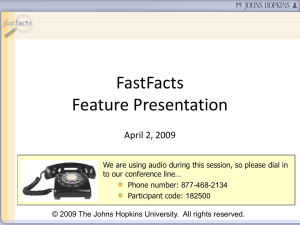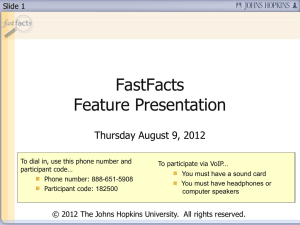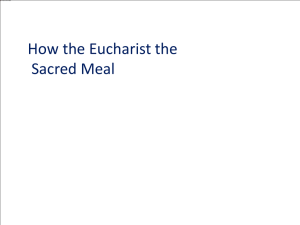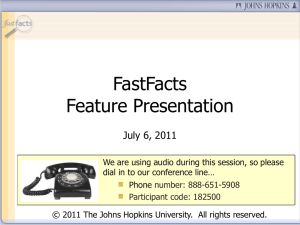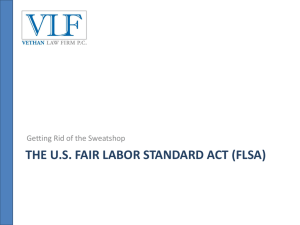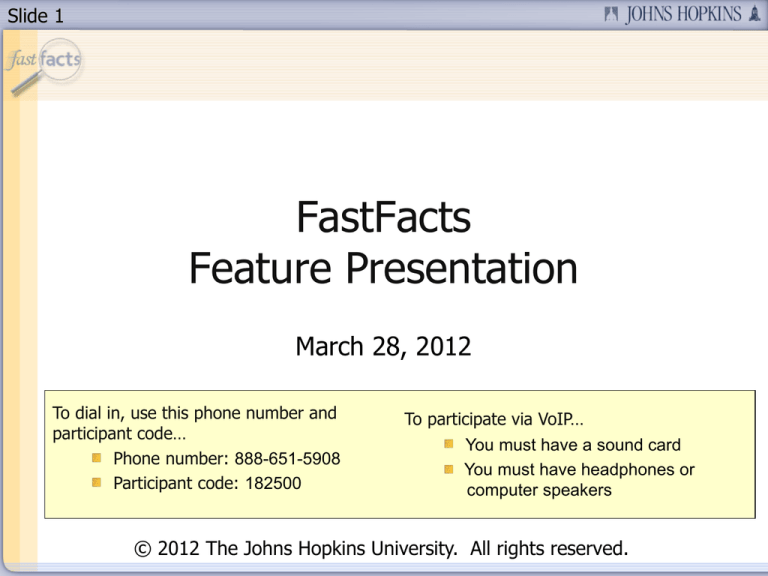
Slide 1
FastFacts
Feature Presentation
March 28, 2012
To dial in, use this phone number and
participant code…
Phone number: 888-651-5908
Participant code: 182500
To participate via VoIP…
You must have a sound card
You must have headphones or
computer speakers
© 2012 The Johns Hopkins University. All rights reserved.
Slide 2
Today’s Topic
We’ll be taking a look at…
Hours Worked under the Fair Labor Standards Act
Comp Time vs. Time Off Plan
Slide 3
Today’s Presenter
Jill Horn
Compensation Manager for The Johns Hopkins University
Place picture of Presenter
Name here
Slide 4
Session Segments
Presentation
Jill will talk about what constitutes paid working time.
During Jill’s presentation, your phone will be muted.
Q&A
After the presentation, we’ll hold a Q&A session.
We’ll open up the phone lines, and you’ll be able to ask
questions.
Jill will answer as many of your questions as time allows.
Slide 5
Contact Us
If you would like to submit a question during the presentation or if
you’re having technical difficulties, you can email us at:
fastfacts@jhu.edu
You can also send us an instant message!
GoogleTalk – HopkinsFastFacts@gmail.com
AOL Instant Messenger – HopkinsFastFacts
MSN – FastFacts@jhu.edu
Slide 6
Survey
Survey
At the end of this FastFacts session, we’ll ask you to complete a
short survey.
Your honest comments will help us to enhance and improve
future FastFacts sessions.
Slide 7
How To View Full Screen
Slide 8
Hours Worked and Time Off Plans
Slide 9
FastFacts Series on Compensation Topics
Four FastFact sessions:
1. Hours Worked and Time Off Plans
2. Understanding & Calculating Regular Rate
(April 24, 2012)
3. Tracking Time in E210 & Processing Overtime in SAP
(May 10, 2012)
4. Overtime Pay – Real Life Scenarios & Special Issues
(June 7, 2012)
This presentation applies to university non-bargaining unit
employees.
Slide 10
What Are Hours Worked?
Compensable work time under the Fair Labor Standards Act (FLSA)
FLSA governs labor practices
JHU is covered by the FLSA
Applies to non-exempt employees
Applies regardless of where the work is performed (i.e., at home)
Slide 11
“Suffered or Permitted”
Work not requested but suffered or permitted to be performed
Must be paid for by employer
Even if employee does not obtain permission to work additional
hours
Employees who work without prior authorization must be
paid but may be subject to disciplinary action (JHU policy)
Even if performed during lunch or before start time
Even if employee does not want to be paid (e.g., volunteering
time to get work done)
Slide 12
Waiting Time – “Engaged to Wait”
Counted as hours worked when:
Employee is unable to use the time effectively for his or her own
purposes; and
Time is controlled by the employer
Not counted as hours worked when:
Employee is completely relieved from duty; and
Time is long enough to enable the employee to use it effectively
for his or her own purposes
Determining when waiting time is compensable may not always be
straightforward. Consult with HR.
Slide 13
On-Call Time
Counted as hours worked when:
Employee has to stay on the employer’s premises
Employee has to stay so close to the employer’s premises that
the employee cannot use that time effectively for his or her own
purposes
Not counted as hours worked when:
Employee is required to carry a pager
Employee is merely required to leave word at home or with the
employer on where he or she can be reached
Determining when on-call time is compensable may not always be
straightforward. Consult with HR.
Slide 14
Rest & Meal Periods
Meal periods are not hours worked when:
Meal break is generally at least 30 minutes
Employee is free to leave his or her work area
Employee is relieved of duties for the purpose of eating a meal
Rest periods of short duration (normally 5-20 minutes) are counted
as hours worked and must be paid
Breastfeeding breaks
Law requires provision of “reasonable” unpaid breaks to nursing
mothers for up to one year every time they need to express
breast milk
Required to provide employees a private location other than
bathroom
Slide 15
Sleep Time
Less than 24 hour duty
Employee who is on duty for less than 24 hours and must work
when required is considered to be working even if allowed to
sleep or engage in other personal pursuits
Duty of 24 hours or more
Employers can exclude bona fide sleep* and meal periods
* Bona fide sleep = Regularly scheduled sleeping period of no
more than 8 hours with adequate sleeping facilities, minimum 5
hours uninterrupted sleep time, and employer/employee
agreement to exclude sleep time
Slide 16
Lectures, Meetings, & Training Programs
Time employees spend in meetings, lectures, or training is
considered hours worked and must be paid, unless all of the
following criteria are met:
Attendance is outside regular working hours, and
Attendance is voluntary, and
The course, lecture, or meeting is not job related, and
The employee does not perform any productive work during
attendance
Slide 17
Travel Time
Whether time spent traveling is work time depends upon the kind of
travel involved
Ordinary “home to work” travel is not work time
Travel to alternative work site is still normal “home to work”
travel
Travel between job sites during the normal work day is work time
Slide 18
Travel Time – Special Rules
Special rules apply to travel away from the employee’s home
community
Example:
Employee required to travel to NYC for day
Travel time 8:00 a.m. to 7:00 p.m.
Normal working hours 9:00 a.m. to 5:00 p.m.
Time traveling and working is compensable EXCEPT:
“Home to work” travel, i.e., home to train station
– Only include amount of time that is similar to amount of
time spent in normal commute from home to work
Meal time
Slide 19
Travel Time – Overnight
Considered work time when…
Travel is during the employee’s regular working hours whether
or not employee actually performs work
Travel is during regular working hours on non-working days such
as Saturday or Sunday
Employee performs work while traveling
Employee is required to operate vehicle or other mode of
transportation
Meal times still deducted from hours worked
Slide 20
Travel Time – Overnight
Not considered work time when…
Travel time outside of regular working hours as a passenger is
not compensable time
Other consideration…
If the employee has option of public transportation but chooses
to drive, the employer may count hours worked as either the
driving time or the time using public transportation
Slide 21
Travel Time – Overnight Example
Scenario
Non-exempt employee
Standard work schedule is M-F 8:30 a.m. to 5:00 p.m.
Normal home to work commute time is 30 minutes
Sent from Baltimore to Florida for work conference
Travels to Florida via airplane Sunday from 9:00 a.m. to 4:00 p.m.
Leaves house at 8:30 a.m. to drive to Baltimore airport
Takes 30 minutes to eat meal while traveling
Leaves airport in Florida at 4:00 p.m. to take train to hotel;
arrives at hotel at 5:00 p.m.
Travels home via airplane Tuesday from 4:30 p.m. to 10:30 p.m.
Leaves hotel in Florida at 4:00 p.m. to take taxi to airport
Spends 2 hours on plane working
Slide 22
Travel Time – Overnight Example
Sunday: Total Hours Worked is 7.5 hours
6.5 hours: airplane travel during working hours minus 30 minute
meal time
1 hour: train travel to hotel
Travel from house to airport not included even though it was
during normal working hours because it is considered “home to
work” travel
Tuesday: Total Hours Worked is 3 hours
½ hour: taxi travel to airport during working hours
½ hour: airplane travel from 4:30 p.m. to 5:00 p.m. (time after
5:00 p.m. not included because not during working hours)
2 hours: working on airplane
Slide 23
Travel Time – Overnight Example
What if employee was required to drive from Baltimore to Florida?
All driving time would be considered hours worked whether or
not during normal working hours
Meal times excluded
What if employee chose to drive?
Employer may determine hours worked by using either the
driving time or the time using public transportation
Slide 24
Other Situations
Preliminary & Postliminary activities
Activities performed before or after employee’s specified work
schedule
Compensable if “integral and indispensable” to an employee’s
“principal activities” (Not clearly defined)
“Continuous workday” – all activities between first and last
principal activity on a work day are compensable
Non-compensable activity example:
Employee working at restaurant at airport
Required to pass through security screening
Activity required by airport not restaurant; restaurant not
benefited
Slide 25
Other Situations
Compensable activity examples:
Donning and doffing clothing (depends on circumstances)
Takes place on employer’s premises
Heavier and/or more unique gear or uniform, i.e., mesh
apron, shin & arm guards, special suit for working with
hazardous material
Maintenance of machinery
E.g., employee who operates machinery is required to oil and
clean it in order to operate
Slide 26
De Minimis Rule
Allows for insignificant periods of time outside scheduled working
hours to be disregarded in recording working time
Applies only where a few seconds or minutes of work are involved
and where the failure to count such time is due to considerations
justified by industrial realities, e.g., cannot as a practical
administrative matter be precisely recorded for payroll purposes
De minimis definition varies, e.g., $1+ of additional pay, 10 minutes
additional time, etc.
Slide 27
Keeping Track of Hours Worked
Complete and accurate records of hours worked is required by FLSA
and JHU Policy for non-exempt staff
E210 is not only a leave tracking system; should be used to record
actual hours worked
Non-exempt employees need to record their work hours weekly and
supervisor/timekeeper needs to review time sheets weekly
Additional pay for hours worked beyond regular standard hours
must be submitted in SAP for payment within the next pay
period
Slide 28
Comp Time vs. Time Off Plan
Comp Time – The substitution of additional hours worked today for
leave at a later date in a following pay period
Not permitted by law (Private employers like JHU)
Time Off Plan – Allows time off during the same pay period in
which the employee worked in excess of the standard work week
Permissible but difficult to administer properly
Discourage the use of time off plan
Slide 29
Implementing Time Off Plan
Calculating time off for hours worked…
… in excess of standard work week but less than 40 hours:
1 hour worked equals 1 hour time off
… in excess of 40 hours:
1 hour worked equals 1.5 hours time off
Overtime hours can only occur in the first week of the pay period
and the leave (time off) must be taken in the second week of the
same pay period
Unless you can give time off in the same pay period in which the
overtime was incurred, the employee must be paid accordingly for
all hours worked by submitting a Bonus/Supplemental ISR
Slide 30
Summary
Hours Worked
Compensable work time under Fair Labor Standards Act
Required to pay non-exempt employees for all time worked
Understanding what constitutes Hours Worked:
Wait Time, On Call Time, Meal & Rest Periods, Sleep Time,
Travel Time, Lectures, Meetings, Training, Preliminary and
Postliminary Activities
Time Off Plan
Allows time off during the same pay period in which the
employee worked in excess of the standard work week
Slide 31
FastFacts Series on Compensation Topics
As a reminder, the other FastFacts in this series will cover the
following topics:
1. Understanding & Calculating Regular Rate
(April 24, 2012)
2. Tracking Time in E210 & Processing Overtime in SAP
(May 10, 2012)
3. Overtime Pay – Real Life Scenarios & Special Issues
(June 7, 2012)
Slide 32
Q&A
We’re going to open the phone lines now!
There will be a slight pause, and then a recorded voice will provide
instructions on how to ask questions over this conference call line.
We’ll be answering questions in the order that we receive them.
We’ll also be answering the questions that were emailed to us
during the presentation.
If there’s a question that we can’t answer, we’ll do some research
after this session, and then email the answer to all participants.
Slide 33
Thank You!
Thank you for participating!
We would love to hear from you.
Are there certain topics that you would like us to cover in future
FastFacts sessions?
Would you like to be a FastFacts presenter?
Please email us at: fastfacts@jhu.edu
Slide 34
Survey
Before we close, please take the time to complete a short survey.
Your feedback will help us as we plan future FastFacts sessions.
Click this link to access the survey…
http://connect.johnshopkins.edu/fastfactssurvey/
Thanks again!

